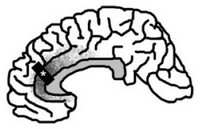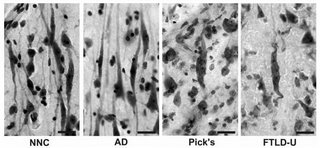Gambling On Obscurity
 Well, after a year of blogging here at The Neurocritic, I thought I might still get away with a snarky, end-of-week, throwaway post about a Science paper whose press coverage was overshadowed by the Great Insula Smokeout.
Well, after a year of blogging here at The Neurocritic, I thought I might still get away with a snarky, end-of-week, throwaway post about a Science paper whose press coverage was overshadowed by the Great Insula Smokeout.Wrong! It appears that one of the authors has commented...
Anonymous said...
Hey Neurocritic--I think you miss the point of the Tom et al. study that just appeared in _Science_.
First: It is actually not so obvious that potential losses would "turn down" responses in the reward centers when people make decisions. Several top researchers had speculated that potential losses would be associated with negative emotional responses as mediated by activity in, say, the anterior insula or amygdala. Second, it is not so obvious that the abstract representation of value when making decisions would involve the same reward circuitry that responds to anticipated or experienced reward. Third, the fact that the reward circuitry is substantially more responsive to potential losses than equivalent gains is not so obvious--it is difficult to reconcile with rational choice models but supports prospect theory, the leading behavioral model of decision under uncertainty for which Daniel Kahneman won the 2002 Nobel Memorial Prize in Economic Sciences. Fourth, the finding that individual differences in sensitivity in this particular circuitry are very highly correlated with individual differences in risk attitudes is exciting and also supports the prospect theory interpretation of risk aversion for mixed (gain/loss) gambles. Fifth, the ancillary finding of a positive correlation between gain and loss sensitivity is rather surprising. Sixth, mapping out the relationship between the dopaminergic circuitry and risk-taking behavior is a first step that may eventually lead to better understanding and treatment for compulsive gambling behavior--for instance, as often exhibited by Parkinsons patients after they begin a regimen of dopamine agonist medication.
It is easy to make fun of a study after reading only a headline. But with all due respect I find your critique naive and superficial.
-cf
11:53 AM
The Neurocritic said...

Sorry, CF, my reward circuitry was turned way down. I did read the paper, but looming deadlines prevented me from writing a full critique. Apologies for that. I'm usually quite thorough.
A few questions and comments for you, if I may:
(1a) Many other studies have indicated that potential losses are associated with negative emotional responses. So the difference here is that the participants never knew the results of their decisions in the Tom et al. study, i.e., there were no consequences during scanning. If there are no immediate consequences, doesn't that change one's response?
McClure SM, Laibson DI, Loewenstein G, Cohen JD. Separate neural systems value immediate and delayed monetary rewards. Science. 2004 Oct 15;306(5695):503-7.
Relevant here??
(1b) There were 3 runs, and subjects were told that only one gamble from each of these runs would be played; i.e., there were only 3 "real" gambles for the entire experiment (albeit which ones was unknown).
(1c) Supplement, page 3: In order to encourage participants to reflect on the subjective attractiveness of each gamble rather than revert to a fixed decision rule (e.g., accept only if gain ≥ 2 × loss), we asked them to indicate one of four responses to each gamble (strongly accept, weakly accept, weakly reject, and strongly reject) using a four-button response box. We also instructed them to respond as quickly as possible within the 3-second trial duration.
People typically aren't rushed into making 256 decisions in 12.8 minutes (a total of 24.7 minutes including the interstimulus intervals). I fail to see how this experimental design relates to making momentous life decisions (see point #7 below regarding press coverage). Or to compulsive gambling behavior, for that matter, since win/loss results aren't withheld until the end of the session in Vegas.
ADDENDUM:
(1d) I forgot to mention that entire models (Holroyd and Coles, 2002) and entire research programs (Schultz, 2006) are based around the notion that the activity of mesencephalic dopamine cells is sensitive to potential gains and losses. Didn't see those particular articles cited in the paper.
Schultz and colleagues have proposed that the dopamine neurons are sensitive to changes in the prediction of the "goodness" of ongoing events: A positive dopamine signal is elicited when an event is better than predicted, and a negative dopamine signal is elicited when an event is worse than predicted. [quote from Holroyd and Coles, 2002]So the Tom et al. study is truly novel in demonstrating that potential losses "turn down" responses in the reward centers??
[end addendum]
(2) ...not so obvious that the abstract representation of value when making decisions would involve the same reward circuitry that responds to anticipated or experienced reward.
Yes? No?
Nieuwenhuis S, Heslenfeld DJ, von Geusau NJ, Mars RB, Holroyd CB, Yeung N. Activity in human reward-sensitive brain areas is strongly context dependent. Neuroimage. 2005 May 1;25(4):1302-9.
(3) I don't know anything about prospect theory versus rational choice models, but I thought Kahneman (and neuroeconomists, e.g., Sanfey et al., 2006 TICS) had already tipped the scales way in favor of the former.
(4) Many of the correlations with individual differences in risk aversion are, indeed, interesting. A question about the one of the puzzling relationships:
For increasing gains, we observed a significant correlation with behavioral loss aversion in the sensorimotor cortex and superior frontal cortex (fig. S4).
What is the significance of this result? Why sensorimotor cortex??
(5) Page 4: the ancillary finding of a positive correlation between gain and loss sensitivity is rather surprising. OK, I'll take your word for it.
(6) I'm not a funding agency, you don't have to justify the broader impacts ("future patients may benefit...").
(7) It wasn't only the headlines that prompted my admittedly snarky post, it was some of the quotes in the article, e.g., extrapolations to scenarios such as leaving a bad marriage, taking cocaine, eating chocolate, and looking at a beautiful face.
Thanks for taking the time to comment on the paper.
1:48 PM
Subscribe to Post Comments [Atom]































